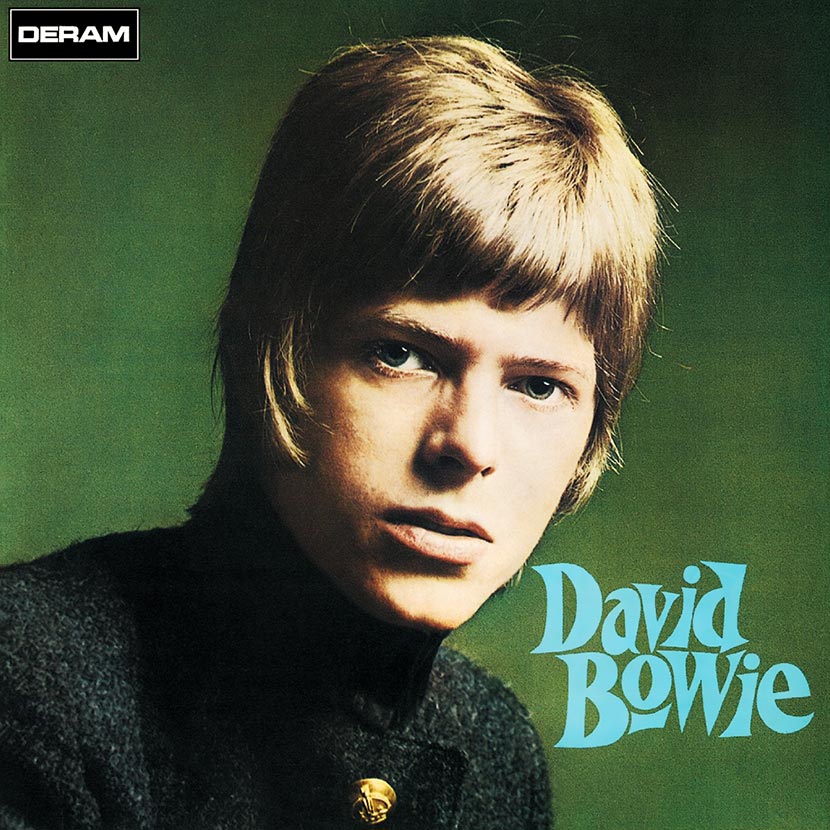
“The homeward road is long.
You’ve left your prayers and song.”
David Bowie was known for being a musical shapeshifter, adapting to new scenes and genres, and creating accomplished and original works within those templates. That is to say, he was not really a musical pioneer, but instead he was always trying to assimilate and improve upon something that existed. T. Rex started the glam movement, Brian Eno was the originator of what would become Bowie’s “Berlin” period, and his industrial phase in the 1990s was pulled from Trent Reznor’s (Nine Inch Nails) playbook. Bowie eventually became a master at his game of charades, but before he became Ziggy Stardust, The Thin White Duke, or Aladdin Sane, he began his career inauspiciously with a ditty-filled self-titled debut.
At this early stage, Bowie had not quite found his musical footing, though thematically the album does point forward to his future work. The common comparison for this oddball in Bowie’s canon is the music of Syd Barrett, the early leader of Pink Floyd. They both present as slightly childish (and maybe a little bit creepy), but Barrett’s work was much less conventional than that of the young Bowie. Bowie wouldn’t create anything like the experiments on Piper at the Gates of Dawn (1967) until he was already an established artist.
Stylistically, David Bowie is played very safe. It is like a lite version of The Kinks, with the session musicians playing competently but not providing much else. There is no ‘rock’ to be found—the songs are all softly strummed acoustics, tinkly pianos, and smooth orchestration. The best of the songs see Bowie singing with a wink in his voice. ‘Sell Me A Coat’ and ‘Love You Till Tuesday’ are the best of the lot, hitting a sweet spot between acknowledged triteness and earnest artistic endeavor.
In the 1970s, Bowie would become an expert showman, cultivating his various personas and emphasizing the theatrical aspect of his art as well as his increasing bag of musical tricks. He is already posing here, but is only capable of mimicry, failing to provide anything very noteworthy, let alone innovative. (And it’s not a knock on the practice of posing to say that the masks he wears here don’t seem to fit him perfectly.1)
While the music is embedded in standard structures—aside from pop, he also is clearly influenced by vaudeville and music hall acts—the lyrical content is decently unique. Bowie’s lyrical themes are where his debut most clearly points toward the future. ‘There Is A Happy Land’ distinguishes children as fundamentally different from adults. “There is a happy land where only children live. They don’t have the time to learn the ways of you sir, Mr. Grownup.” ‘She’s Got Medals’ is a tale of a woman posing as a man to join the military before returning to civilization as a woman, years before the ambiguous posturing of Ziggy Stardust (or for that matter, Bowie posing in a dress on the cover of The Man Who Sold The World). He becomes a “messiah” on ‘We Are Hungry Men’—a song which also contains lyrics about cannabalism, abortion, and infanticide, sung in a lighthearted and nonchalant manner. ‘Little Bombardier’ is a startling song about a child molester that might go unnoticed if the song is listened to superficially (which I do all the time).
Only a few songs flirt with the psychedelia that Barrett (and others, of course) were working on at the time—most notably ‘Silly Boy Blue’. ‘Please Mr. Gravedigger’ closes the album with the recitation of a macabre poem backed by church bells, rain, sneezes, and sniffles, and it doesn’t really fit at all with the rest of the album. By summer 1967—the Summer of Love—psychedelic music was in, and light, breezy Britpop was out. The Kinks delightful Something Else (featuring personal favorite ‘Waterloo Sunset’) failed to achieve commercial success, and likewise Bowie’s debut was mostly overlooked. Two years later, he would also pretend it didn’t exist, self-titling his sophomore effort as well (though it would later be called Space Oddity to capitalize on the surprise hit).
The album is pleasant enough; it is just insubstantial, and doesn’t really reach anything close to the level of Bowie’s later work. He had not quite learned to fully embrace the theatricality that would color his best albums, and his chosen genre was simply out of style when his album released. It is a fun artifact for die-hard Bowie fans, and could appeal to fans of jaunty 1960s pop music. But if you are looking for glam rocker Bowie, he is not here yet—only his quirky thematic predilections come through clearly. Perhaps a more astute listener can pick through the album and find some other rudimentary elements that were developed further, but such a chore is not worth it for me.
The Deram Anthology—a compilation of music Bowie recorded for Deram Records in the latter half of the 1960s—contains the debut album in its entirety, along with thirteen other tracks. Some of them are alternate versions of songs on the album, while several of the “new” songs indicate a more psychedelic and rock ‘n’ roll flavoring, predicting what was to come, and the closer is a demo version of ‘Space Oddity’. If you’re looking to purchase a CD of the album, get The Deram Anthology. It’s usually a better price, and includes some nice bonuses from the early Bowie era.
Favorite Tracks: Sell Me a Coat; Love You till Tuesday; Silly Boy Blue.
1. It would be disingenuous to say that posing in general is a negative characteristic for musicians (or entertainers in general). For instance, Jim Morrison was perhaps more into the “act” of being a famous musician than any of his contemporaries, and his work is mostly celebrated. Whether it was calculated or organic, his self-affected rebel persona aligns well with the outsider self-mythology of rock culture. And, as I alluded to earlier, Bowie himself would come to inhabit various roles successfully throughout his career.